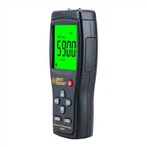The difference between a regular multimeter and a digital multimeter
A pointer multimeter is an average type instrument with intuitive and visual reading indication
(Generally, the reading value is closely related to the swing angle of the pointer, so it is very intuitive)
A digital multimeter is an instantaneous sampling instrument that uses a sample taken every 0.3 seconds to display measurement results. Sometimes, each sampling result is only very similar and not exactly the same. This is not as convenient for reading results as a pointer type
A pointer multimeter generally does not have an amplifier internally, so its internal resistance is small. For example, the MF-10 model has a DC voltage sensitivity of 100 kiloohms/volt. This is considered excellent. The MF-500 model has a DC voltage sensitivity of 20 kiloohms/volt
Due to the internal use of an operational amplifier circuit, the digital multimeter can have a large internal resistance, often at 1M ohms or higher (i.e., higher sensitivity can be obtained). This allows for a smaller impact on the tested circuit and higher measurement accuracy
Due to the small internal resistance and the use of discrete components to form a shunt voltage divider circuit, the frequency characteristics of a pointer type multimeter are uneven (compared to digital ones). However, the frequency characteristics of a pointer type multimeter are relatively better
The internal structure of the pointer type multimeter is simple, so its cost is low. It has fewer functions, simple maintenance, and strong overcurrent and overvoltage capabilities
The digital multimeter uses various internal oscillation, amplification, frequency division, protection circuits, etc., so it has many functions, such as measuring temperature, frequency (in a lower range), capacitance, inductance, or as a signal generator
Due to the use of multiple integrated circuits in the internal structure, the overload capacity is poor (However, some of them can now automatically shift gears, protect themselves, etc., but their use is more complex). After damage, it is generally not easy to repair
The output voltage of a digital multimeter is relatively low (usually not exceeding 1 volt). It is inconvenient to test some components with special voltage characteristics (such as thyristors, light-emitting diodes, etc.)
The output voltage of the pointer multimeter is relatively high, such as 10.5 volts, 12 volts, etc
The current is also large (such as MF-500 * 1 ohm range with a maximum of about 100 milliamperes), which can facilitate testing of thyristors, light-emitting diodes, etc
For beginners, a pointer type multimeter should be used
For non beginners, two types of instruments should be used





